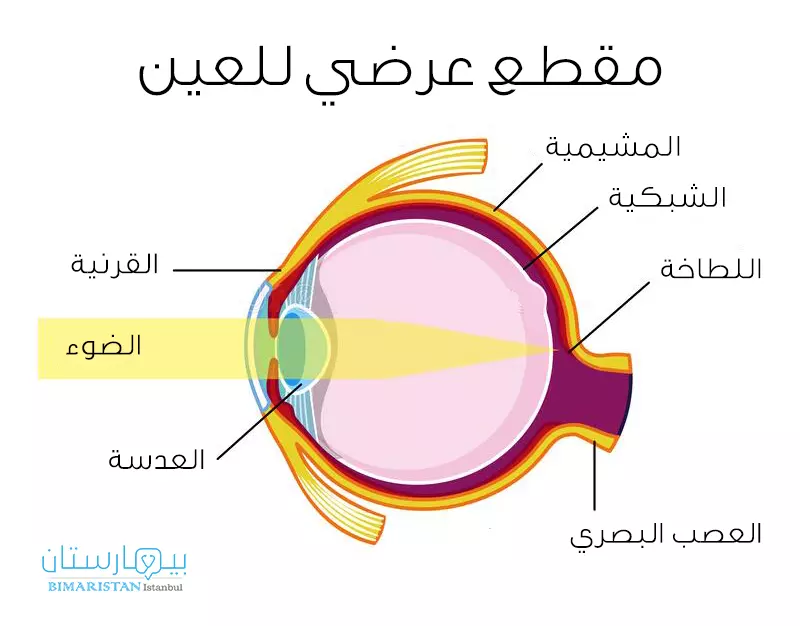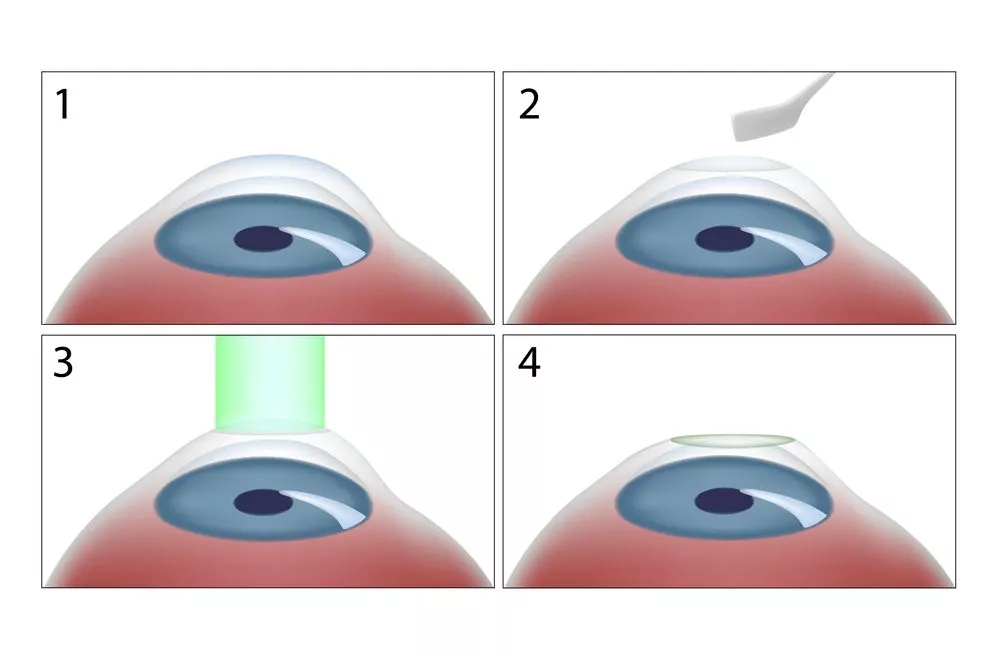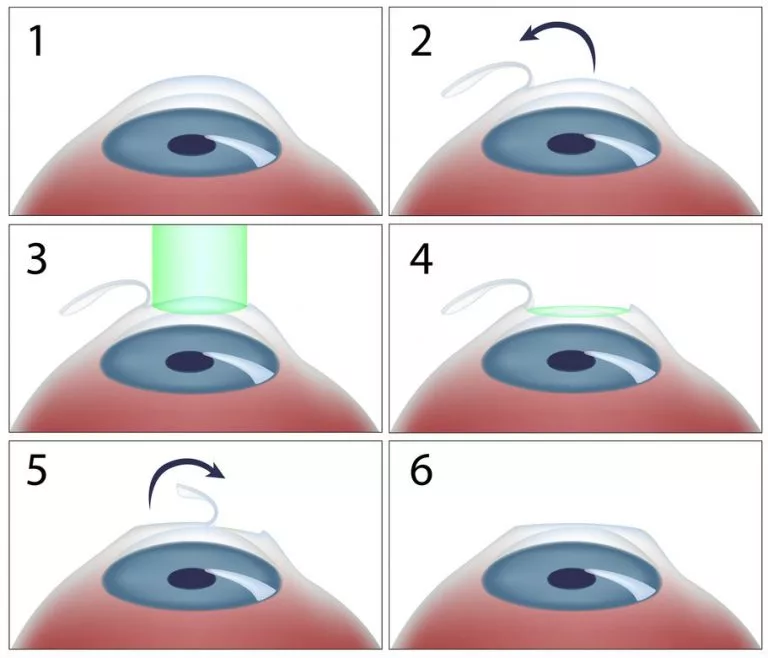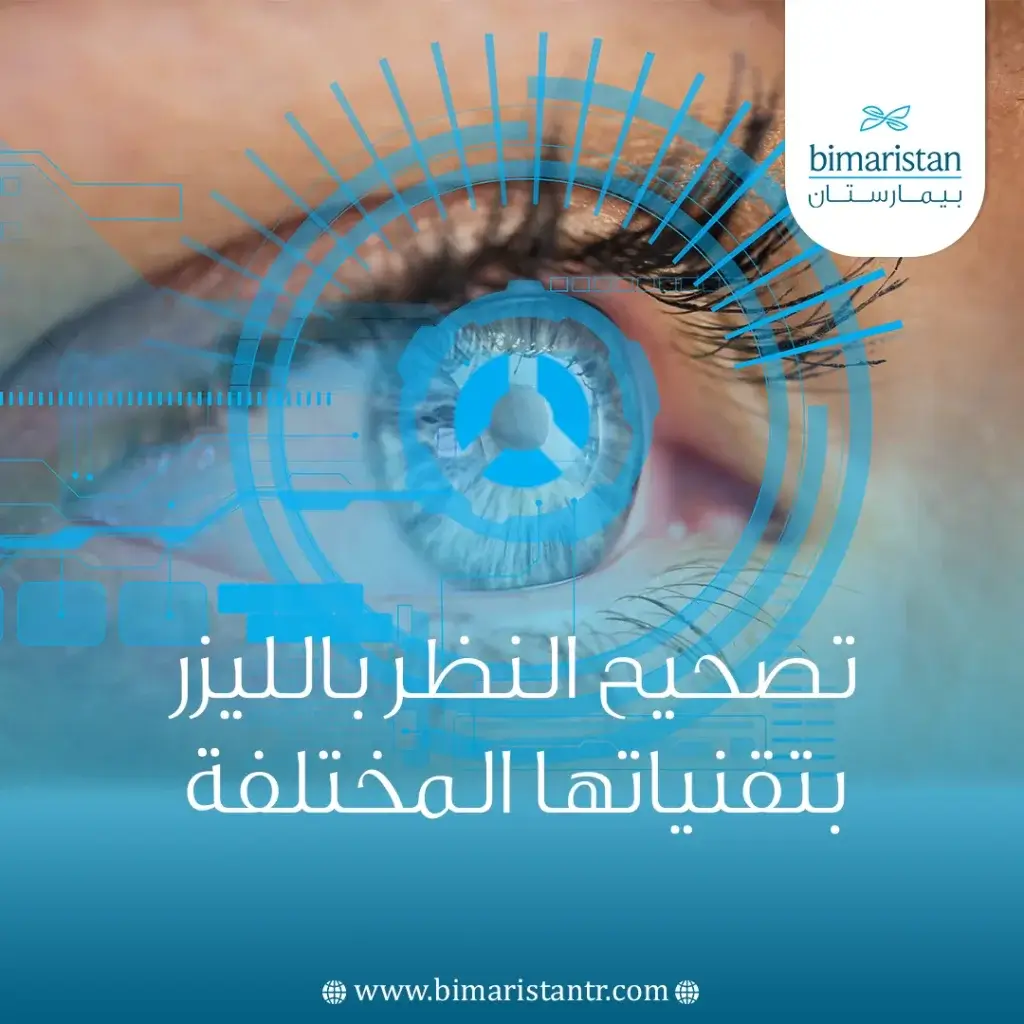تصحيح النظر بالليزر من العمليات الدقيقة التي تصحح مشاكل النظر الناجمة عن أسواء الانكسار ومنها قصر النظر وطول النظر والانحراف، تسمح جراحة تصحيح النظر للأطباء بتغيير تحدب القرنية الظهاري بالليزر.
ماهو مبدأ عمليات تصحيح النظر بالليزر (الليزك)؟
للعين العديد من السطوح الكاسرة (القرنية، البلورة) التي تعمل معاً على كسر الشعاع الضوئي القادم إلى العين بشكل مناسب ليتوضع على الشبكية بمنطقة محددة، التي تنقل بدورها الطاقة الضوئية القادمة إليها إلى الدماغ على شكل سيالة عصبية ليتم تحليلها وتفسيرها.
إن وقوع الخيال على الشبكية بنقطة معينة هو الأهم للحصول على رؤية واضحة.

لتصحيح عيوب الإبصار (طول نظر و قصر البصر، واللابؤرية أو الانحراف) يمكن استخدام العدسات اللاصقة أوالنظارات الطبية التي تشكل بدورها سطوح كاسرة إضافية تساهم بوضع الخيال على الشبكية، كما يمكن اللجوء إلى الحل الجراحي باستخدام أشعة الليزر.
يتم تصحيح مشاكل النظر جراحياً عن طريق تغيير انحناءات (تحدب) السطح الأمامي للقرنية بواسطه الليزر وبذلك تتغيير القوة الانكسارية للقرنية، نلجأ لهذه الطريقة عند رغبة المريض بعدم ارتداء النظارات الطبية والعدسات اللاصقه.
تستخدم هذه العمليه لعلاج عيوب الإبصار الانكسارية كقصر أو طول النظر، قصر البصر الشيخي و الانحراف (الاستجماتيزم).
تستغرق عمليه تصحيح النظر بالليزر حوالي 15 دقيقة ، وتجرى للعينين معاً بنفس الوقت.
قد يهمك أيضاً : تفاصيل عملية جراحة الساد
احدث تقنيات تصحيح النظر
تطورت جراحة تصحيح النظر بالليزر بشكل سريع خلال آخر خمسين عام، وأصبح لها اليوم أنواع عديدة لنستعرض معاً هذه التقنيات:
1. بضع القرنية السطحي (RK):
تعتبر أول التقنيات بعمليات تصحيح النظر ، يستخدم فيها الطبيب أدوات خاصة لتغيير و إعادة تشكل سطح القرنية يدوياً ، حققت هذه العمليه تحسن بالرؤية ولكن آثارها الجانبية كرؤية هالات الضوء قد تستمر طويلاً.
في ثمانينات القرن الماضي تم البدء باستخدام أشعة الليزر في مجال طب العيون، مما أحدث ثورة في عمليات تصحيح النظر.
2. كشط القرنية بالليزر (أو كما تسمى أيضاً الجراحه الانكسارية للقرنية PRK):
نستخدم في هذا الإجراء أشعه الليزر laser لكشط طبقة رقيقة من سطح القرنية.
تعتبر من أول العمليات الناجحة التي تم إجراؤها. لم تعد شائعة في يومنا هذا ، ويقتصر استخدامها اليوم لتصحيح النظر لذوي القرنية الرقيقة وقليلة السماكة.

الألم بعد العملية والوقت الطويل المطلوب لتعافي النظر مقارنةً بعملية الليزك lasik ، والنتائج المشابهة بينهما. كل هذه العوامل جعلت عملية الليزك lasik جراحة رائدة بمجال تصحيح النظر بالليزر.
3.عملية الليزك lasik:
تعتبر عملية الليزك أكثر عمليات تصحيح النظر شيوعاً. يتم فيها عمل شق بـ سطح القرنية بواسطة أشعة الليزر، وبعدها يتم تسليط شعاع الليزر laser مباشرةً لنسيج القرنية الداخلي بهدف إعادة تشكيله بالشكل المطلوب ، ومن ثم تُعاد الطبقة الخارجية لوضعها السابق وتلتحم لوحدها بدون غرز.

ألم قليل ونتائج فورية هذا أهم ما يميز عملية الليزك لتصحيح النظر ويجعلها من اكثر عمليات تصحيح النظر شيوعا.
4. تقنية سمايل (SMILE):
بهذه التقنية نستخدم الليزر laser لتصحيح النظر دون إحداث شقوق بالقرنية ، مما يقلل من ظهور مضاعفات مزعجة بعد العمليه.
تعد تقنية SMILE خياراً مناسباً لمرضى قصر النظر ، ومرضى جفاف العيون المزمن.
5. زراعة حلقات القرنية:
يجرى شق سطحي بالقرنية و يتم زراعة حلقات مصنوعة من مادة خاصه على طرفي القرنيه ، إن إستخدام عملية زرع الحلقات بالقرنية محصور في عيوب الرؤية ( انحراف وطول النظر ) التي تسببها القرنيه المخروطية.
تهدف جميع عمليات تصحيح النظر بالليزر إلى توفير حل دائم للمرضى، ولكن مع تقدم العمر قد يحتاج الشخص الذي أجرى عملية تصحيح نظر بمساعدة الليزر بالثلاثينيات أو العشرينيات من عمره لنظارات قراءة في وقت لاحق من حياته.
قد يهمك أيضاً : عملية زراعة عدسة العين بالليزر في تركيا
شروط عملية الليزر للعيون
لتكون عملية تصحيح النظر بالليزر خياراً مناسباً لك ، يجب تحقيق الشروط التالية:
- رؤية مستقرة لمدة عامين أو اكثر.
- العمر فوق 21 عام.
موانع عملية تصحيح النظر
- وجود مرض عيني خارجي (التهابات ملتحمة متكررة ، التهاب حواف الأجفان).
- لا تجرى عملية الليزك لدى مرضى جفاف العيون المزمن.
- تعتبر القرنية المخروطية والحمل مضادا استطباب لإجراء عملية تصحيح النظر بواسطة الليزر.
- وجود مرض عيني كالزرق أو الساد.
- لا تجرى جراحة تصحيح البصر بالليزر عند مرضى اعتلال الشبكية السكري و الذئبة الحمامية.
اقرأ أيضاً : تفاصيل زراعة القرنية في تركيا بدون غرز
ماهي مخاطر عملية تصحيح النظر بالليزر؟
تعتبر جراحة إصلاح مشاكل النظر بواسطة الليزر من العمليات الآمنة، ولكن كأي عمل جراحي آخر يوجد القليل من المخاطر لهذا الإجراء.
جفاف العيون المؤقت بعد الجراحة ، تشوش بالرؤية وحساسية ضوئية عند رؤية وهج قوي كمصابيح السيارات عند القيادة ليلاً ، احمرار في العين، تتراجع هذه الأعراض بعد 6 أشهر من الإجراء.
و بحال وجود أي مخاوف لديك اتصل بطبيبك.
هل عملية تصحيح النظر بالليزر مؤلمة؟
تجرى العملية بعد وضع مخدر موضعي (قطرة عينية) لضمان عدم الشعور بأي ألم خلال العملية.
أثناء عمليه الليزك قد يشعر المريض بالقليل من الضغط على العين بسبب الشق المحدث بالقرنية ، وقد يرافق المريض شعور بعد الراحة يستمر لمدة 24 ساعة بعد الإجراء.
بعد جراحة ال PRK يشعر المريض بتهيج يستمر لأسبوع ريثما تشفى القرنية وتلتئم.
هل أحتاج لفحص عيون دوري بعد عملية تصحيح النظر بالليزر؟
لا بد من إجراء فحص دوري للعيون كل عامين حتى دون وجود أي شكوى بعد اجراء تصحيح النظر بـ الليزر، للمساعدة في التشخيص المبكر لأي مرض قد يهدد الرؤية.
تعرف على أحدث أنواع جراحات تصحيح النظر بالليزر،و ماهي عملية الليزر، وكل ماتريد معرفته عن عمليات تصحيح النظر بالليزر وأحدث تقنيات طب العيون في تركيا عبر التواصل معنا.
نقدم خدماتنا على امتداد تركيا.
نرافقك خطوة بخطوة نحو الشفاء. كما نساعدك على اختيار العلاج المناسب والتعرف على جميع طرق تصحيح النظر بتقنياتها المختلفة.

